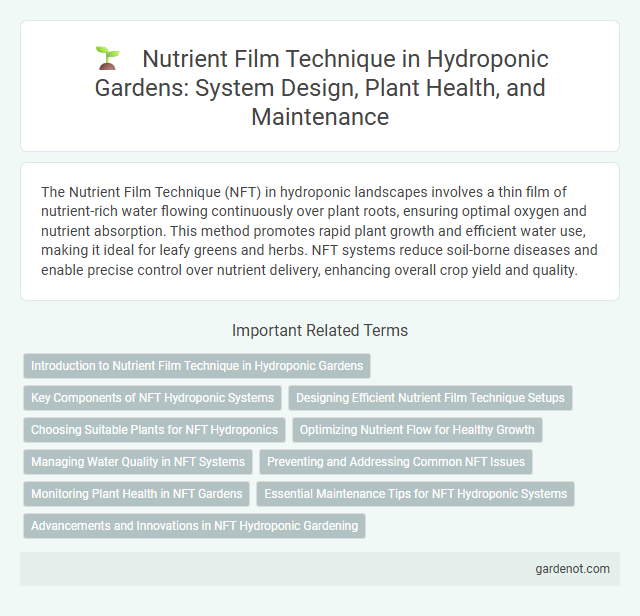The Nutrient Film Technique (NFT) in hydroponic landscapes involves a thin film of nutrient-rich water flowing continuously over plant roots, ensuring optimal oxygen and nutrient absorption. This method promotes rapid plant growth and efficient water use, making it ideal for leafy greens and herbs. NFT systems reduce soil-borne diseases and enable precise control over nutrient delivery, enhancing overall crop yield and quality.
Introduction to Nutrient Film Technique in Hydroponic Gardens
Nutrient Film Technique (NFT) in hydroponic gardens utilizes a thin, continuous flow of nutrient-rich water over plant roots, maximizing oxygen and nutrient uptake. This method supports efficient water use and promotes steady root development by maintaining a constant film of nutrients in sloped channels. Ideal for leafy greens and herbs, NFT systems enhance growth rates while minimizing resource waste in soilless cultivation.
Key Components of NFT Hydroponic Systems
Nutrient Film Technique (NFT) hydroponic systems rely on essential components including a shallow, sloped channel where a thin film of nutrient-rich water continuously flows over the plant roots. A reservoir stores the nutrient solution, which is circulated by a pump through the channels and returned for recirculation, ensuring constant oxygen and nutrient delivery. Key elements also include a support structure to hold plants securely, an aeration system to maintain dissolved oxygen levels, and a timer for precise control of flow cycles.
Designing Efficient Nutrient Film Technique Setups
Designing efficient Nutrient Film Technique (NFT) setups involves optimizing channel slope, flow rate, and nutrient concentration to ensure uniform nutrient distribution and oxygen availability for plant roots. Selecting lightweight, durable materials like PVC or food-grade plastics enhances system longevity and reduces maintenance. Incorporating modular designs with adjustable flow controls allows for scalability and customization to various crop types and growth stages.
Choosing Suitable Plants for NFT Hydroponics
Selecting plants for Nutrient Film Technique (NFT) hydroponics requires consideration of root structure and growth rate to ensure efficient nutrient uptake. Leafy greens like lettuce, spinach, and herbs such as basil thrive in NFT systems due to their shallow roots and fast growth cycles. Avoiding large or root-heavy plants minimizes clogging and promotes optimal water flow in the narrow channels characteristic of NFT setups.
Optimizing Nutrient Flow for Healthy Growth
Nutrient Film Technique (NFT) optimizes nutrient flow by continuously circulating a thin nutrient-rich water film over plant roots, ensuring consistent access to oxygen and essential minerals. Maintaining proper flow rates and nutrient concentrations prevents root suffocation and promotes robust growth in hydroponic systems. Precise control of pH and electrical conductivity (EC) levels further enhances nutrient uptake efficiency for healthy and productive plant development.
Managing Water Quality in NFT Systems
Effective management of water quality in Nutrient Film Technique (NFT) systems is critical to optimizing plant growth and preventing disease. Regular monitoring of pH, electrical conductivity (EC), and dissolved oxygen levels ensures nutrient availability and root health, while maintaining a stable and clean nutrient solution prevents the buildup of harmful pathogens. Implementing filtration and periodic system flushing helps sustain water quality, enhancing overall system efficiency and crop yield.
Preventing and Addressing Common NFT Issues
Maintaining proper water flow and nutrient concentration is critical for preventing root diseases and channel blockages in Nutrient Film Technique (NFT) hydroponic systems. Regularly inspecting channels for algae buildup and ensuring consistent oxygenation can mitigate root rot and enhance nutrient absorption. Implementing automated monitoring systems helps detect pH imbalances and nutrient deficiencies early, promoting healthy plant growth and maximizing yield.
Monitoring Plant Health in NFT Gardens
Monitoring plant health in Nutrient Film Technique (NFT) gardens relies on real-time analysis of nutrient solution parameters such as pH, electrical conductivity (EC), and dissolved oxygen levels. Precise control of these factors ensures optimal nutrient uptake, preventing deficiencies and toxicities that can stress plants. Advanced sensor integration and automated feedback systems enhance disease detection and promote uniform growth in hydroponic landscapes.
Essential Maintenance Tips for NFT Hydroponic Systems
Regularly inspect and clean the channels and pumps in Nutrient Film Technique (NFT) hydroponic systems to prevent blockages and algae buildup. Maintain balanced nutrient solution pH between 5.5 and 6.5 and monitor electrical conductivity (EC) levels frequently to ensure optimal plant growth. Replace nutrient solution every 1-2 weeks and ensure proper oxygenation to sustain healthy roots and maximize crop yield.
Advancements and Innovations in NFT Hydroponic Gardening
Recent advancements in Nutrient Film Technique (NFT) hydroponic gardening have improved nutrient circulation systems by integrating precision sensors and automated pH and EC monitoring, enhancing plant growth efficiency. Innovations include the development of modular NFT channels made from sustainable, UV-resistant materials, which enable easier scalability and maintenance in commercial applications. Advanced nutrient formulations tailored to specific crops and AI-driven data analysis now optimize resource use, resulting in higher yields and reduced waste.
Nutrient film technique Infographic

 gardenot.com
gardenot.com